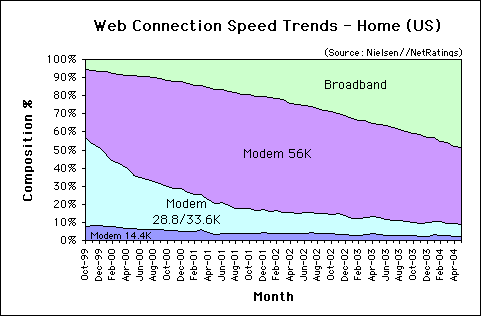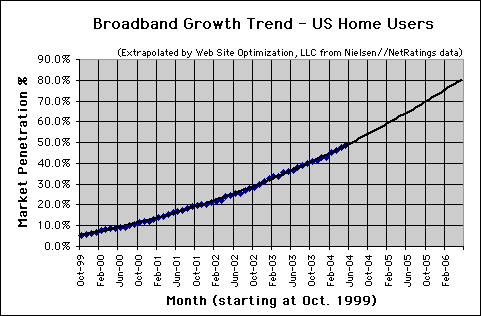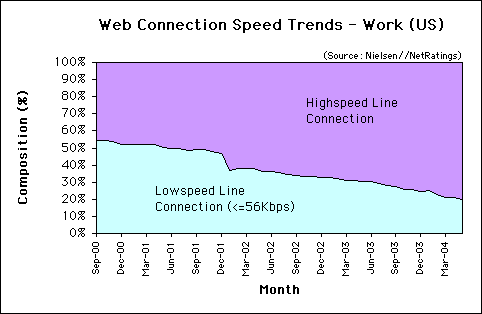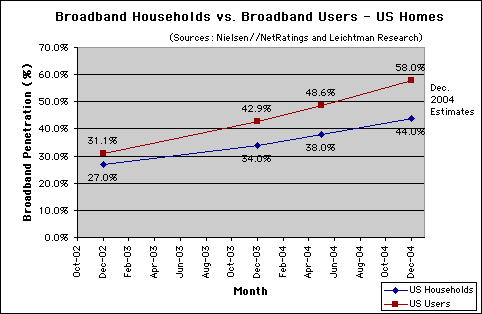US broadband penetration grew by 0.74 percentage points in May, with 48.61% of active Internet users enjoying a high-speed connection at home. 51.39% of US home users dial into the Internet with “narrowband” connections of 56Kbps or less. Meanwhile, the percentage of wired US households with broadband grew to 38% in May, and will exceed 50% by summer 2005.
The charts below, derived from Nielsen//NetRatings and Leichtman Research Group data, show trends in connection speeds to the Internet for United States users and households.*
Home Connectivity in the US
As of May 2004, most users in the US connect to the Internet using dial-up modems of 56Kbps or less. 42.53% use 56Kbps modems, 6.52% use 28/33.3Kbps, and 2.34% use 14.4Kbps modems. In total. 51.39% of home users in the US connect to the Internet at 56Kbps or less (see Figure 1).
Web Connection Speed Trends – Home Users (US)
Figure 1: Web Connection Speed Trends – Home Users (US)
Source: Nielsen//NetRatings
Broadband Growth in the US
Broadband penetration in the US increased by 0.74 points in May. As of May 2004 broadband penetration was at 48.61%, up from 47.87% in April. This jump of 0.74 points is below the average increase in broadband of 0.79 points per month from October 1999 to May 2004. Extrapolating the data provided by Nielsen//NetRatings, broadband share in the US should exceed 50% by July of 2004 (see Figure 2).
Broadband Connection Speed Trend – Home Users (US)
Figure 2: Broadband Connection Speed Trend – Home Users (US)
Extrapolated from Nielsen//NetRatings data
Work Connectivity
Most workers in the US enjoy high-speed connections to the Internet. Most use a high-speed line such as a T1 connection, and share bandwidth between computers connected to an Ethernet network. The speed of each connection decreases as more employees hook up to the LAN. As of May of 2004, of those connected to the Internet, 79.8% of US users at work enjoy a high-speed connection, up from 79% in April. 20.2% connect from work at 56Kbps or less (see Figure 3).
Web Connection Speed Trends – Work Users (US)
Figure 3: Web Connection Speed Trends – Work Users (US)
Source: Nielsen//NetRatings
Broadband Households versus Broadband Users
Broadband penetration can be measured in a number of ways. Two of the most popular are the percentage of broadband users among “active” Internet users, and the percentage of wired households that have broadband. One wired household can have a number of broadband users, so the broadband user measure is invariably higher than broadband households. To compare these two measures we asked Bruce Leichtman of Leichtman Research Group, Inc. to provide some figures for broadband penetration in US households (see Figure 4).
Broadband Households versus Broadband Users – 2002-2004 – US Homes
Figure 4: Broadband Households versus Broadband Users – 2002-2004 – US Homes
Sources: Nielsen//NetRatings and Leichtman Research Group
The data shows that while broadband households and broadband users show similar growth trends, broadband households will break 50% about a year after broadband users. We asked Leichtman how he arrived at his data.
“Leichtman Research Group, Inc. (LRG) bases its findings off of nationwide consumer research studies conducted via telephone (to represent a representative cross-section of all US households). This data is also analyzed in conjunction with our database of provider-side research, as well as other sources – including the FCC.
LRG found that at the end of 2002 about 27% of US households that subscribed to an online service subscribed to a broadband service. At the end of 2003 the share of online subscribers getting broadband grew to 34%, and we forecast that by the end of 2004 this figure will rise to about 44%.
Note that these figures are based on households subscribing to an online service at home, and do not double count for those broadband households that also subscribe to a dial-up ISP (about 10%).
These figures are confirmed by figures from broadband providers along with the FCC. At the end of 2003 the FCC showed that there were about 26 million residential and small business broadband subscribers in the US (while the top 20 cable and DSL providers reported 24.6 million subscribers). If we conservatively estimate that 10% of these are small business it would total 23.4 million households subscribing to broadband at the end of 2003 – if this group represented 42% of all online subscribers that would imply that just 55.7 million households in the US were online – or just 52% of all households. Our data shows that 62% of all US households were online at the end of 2003.”
Further Reading
- A Record 2.3 Million Add Broadband in First Quarter of 2004
- Quarterly broadband uptake from Leichtman Research Group shows that Comcast is leading Time Warner in broadband, and cable is leading DSL by 62% to 38%.
- FCC: Local Telephone Competition and Broadband Deployment
- Broadband penetration data by state from the FCC.
- Leichtman Research Group
- Supplied the US broadband penetration data for wired households in Figure 4 for the Bandwidth Report.
- Nielsen//NetRatings
- Provides the US broadband data (percentage of active Internet users) for the Bandwidth Report.
*Note that Nielsen//NetRatings reports the percentage of active Internet users that use broadband from home, not broadband households. NetRatings uses a panel of 40,000 to 50,000 people with software meters installed on their computers. These meters detect connection speeds. Each month they do an enumeration study to call a number of people to calibrate the panel by adjusting weightings
to match the population at large.
The Bandwidth Report is featured monthly on URLwire – news of useful and unique web content since 1994.




